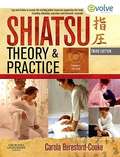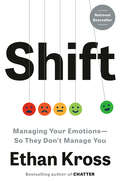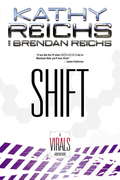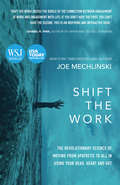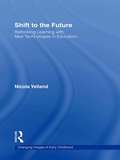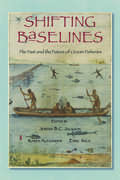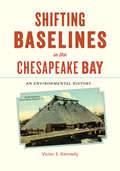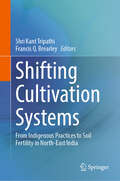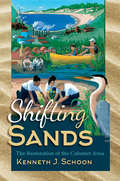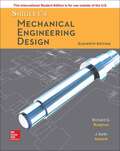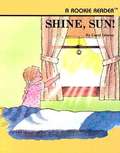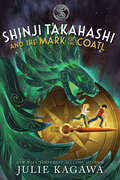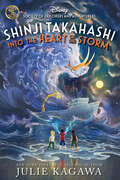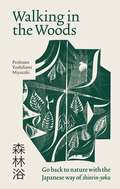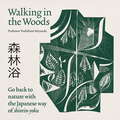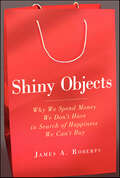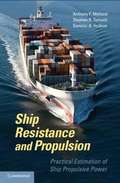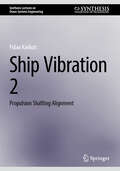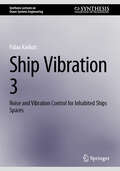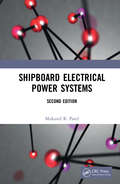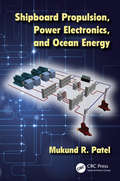- Table View
- List View
Shh! Bears Sleeping
by David MartinIn the fall When leaves turn red Bears know soon It&’s time for bed Comes winter Comes snow Bears are ready Bears go In their cave Warm and deep Winter is time For bears to sleep A lilting read-aloud text and stunning pictures combine to make an irresistibly appealing picture book that follows these fascinating animal friends through the cycle of the year. A page of facts about bears will answer young readers' questions as they begin to explore the wonders of the natural world.
Shiatsu Theory And Practice
by Carola Beresford-CookeThis fully revised and refocussed new edition builds upon its reputation as the core textbook for serious students of shiatsu. Written by a well-known and highly respected author and practitioner within the field, Shiatsu Theory and Practice is a complete introduction to the theory and practice of Zen shiatsu, drawing in detail on the theoretical foundation of both Traditional Chinese Medicine and five element theory. Beresford-Cooke explains the strands of theory in a way which makes their integration into practice clear and rational and step-by-step descriptions of treatment routines and techniques and the inclusion of case histories showing application of theory to practice fully equip the student to practice with confidence.
Shift: Managing Your Emotions--So They Don't Manage You
by Ethan Kross&“A revolutionary guide to mastering your emotional life.&”—Charles Duhigg&“Brilliant, engaging, and deeply insightful.&”—Lisa Damour&“A blueprint for navigating the emotional curveballs that life throws at us every day.&”—The New York TimesINSTANT NATIONAL BESTSELLER • One of Oprah Daily&’s Best Self-Help Books for Personal Growth in 2025, Next Big Idea Club&’s Highly Anticipated Books, and Adam Grant&’s 10 New Books to Feed Your MindA myth-busting, science-based guide that addresses the timeless question of how to manage your emotional life using tools you already possess—from the bestselling author of Chatter.Whether it&’s anxiety about going to the doctor, boiling rage when we&’re stuck in traffic, or devastation after a painful break-up, our lives are filled with situations that send us spiraling. But as difficult as our emotions can be, they are also a superpower. Far from being &“good&” or &“bad,&” emotions are information. When they&’re activated in the right ways and at the right time, they function like an immune system, alerting us to our surroundings, telling us how to react to a situation, and helping us make the right choices. But how do we make our emotions work for us rather than against us? Acclaimed psychologist Dr. Ethan Kross has devoted his scientific career to answering this question. In Shift, he dispels common myths—for instance, that avoidance is always toxic or that we should always strive to live in the moment—and provides a new framework for shifting our emotions so they don&’t take over our lives. Shift weaves groundbreaking research with riveting stories of people struggling and succeeding to manage their emotions—from a mother whose fear prompted her to make a spur-of-the-moment decision that would save her daughter&’s life mid-flight to a nuclear code-carrying Navy SEAL who learned how to embrace both joy and pain during a hellish training activity. Dr. Kross spotlights a wide array of tools that we already have access to—in our bodies and minds, our relationships with other people, and the cultures and physical spaces we inhabit—and shows us how to harness them to be healthier and more successful. Filled with actionable advice, cutting-edge research, and riveting stories, Shift puts the power back into our hands, so we can control our emotions without them controlling us—and help others do the same.
Shift
by Kathy Reichs Brendan ReichsTory's great aunt, Temperance Brennan, visits just in time to investigate a robbery at the Loggerhead Island Research Institute. <P><P>As a renowned forensic anthropologist, Tempe is obviously qualified to figure out whodunit, but Tory and her Virals pack want to crack the case on their own. Yet the crime is puzzling. Who could have accessed the labs at LIRI, and how could they have gotten the equipment off the island? <P> It's Brennan vs. Brennan in this short story that gives readers a brand new insight into the world of the Virals.
Shift the Work: The Revolutionary Science of Moving From Apathetic to All in Using Your Head, Heart and Gut
by Joe Mechlinski70% of the American workforce is disengaged.With every tick of the clock, millions of people inch closer to their breaking points—a growing epidemic of apathy and anxiety in the workplace that is affecting life outside of the office. But meaningful work-life integration is possible.In Shift the Work, Joe Mechlinski, the New York Times bestselling author of Grow Regardless, shares his personal journey to find purpose, and how it influenced him to take a deeper dive into the science of human behavior. Inspired by neuroscience research about the connections between the brains in the head, heart, and gut that drive human perspectives and conduct, Joe shares how everyone can re-engage with their work and impact the world.Filled with actionable strategies and inspiring true stories, this indispensable guide motivates readers to seek fulfilling opportunities, reconnect with their passions, and recognize their power to make a difference.
Shift to the Future: Rethinking Learning with New Technologies in Education (Changing Images of Early Childhood)
by Nicola YellandNew technologies are dramatically changing the face of education and the nature of childhood itself. In Shift to the Future, Nicola Yelland examines the ways in which these technologies are reshaping the social, personal, and educational experiences of childhood, and explores the curricular revisions such changes demand. With a focus on the various information and communications technologies (ICTs) available to young students and the possibilities these ICTs offer for teaching and learning, Shift to the Future provides inspiring examples of teachers who have innovatively incorporated new technologies into their classrooms to engage their students in contemporary times.
Shifting Baselines: The Past and the Future of Ocean Fisheries
by Jeremy B.C. Jackson Enric Sala Karen E. Alexander Francisco Chavez Jeff Bolster Jamie CournaneShifting Baselines explores the real-world implications of a groundbreaking idea: we must understand the oceans of the past to protect the oceans of the future. In 1995, acclaimed marine biologist Daniel Pauly coined the term "shifting baselines" to describe a phenomenon of lowered expectations, in which each generation regards a progressively poorer natural world as normal. This seminal volume expands on Pauly's work, showing how skewed visions of the past have led to disastrous marine policies and why historical perspective is critical to revitalize fisheries and ecosystems. Edited by marine ecologists Jeremy Jackson and Enric Sala, and historian Karen Alexander, the book brings together knowledge from disparate disciplines to paint a more realistic picture of past fisheries. The authors use case studies on the cod fishery and the connection between sardine and anchovy populations, among others, to explain various methods for studying historic trends and the intricate relationships between species. Subsequent chapters offer recommendations about both specific research methods and effective management. This practical information is framed by inspiring essays by Carl Safina and Randy Olson on a personal experience of shifting baselines and the importance of human stories in describing this phenomenon to a broad public. While each contributor brings a different expertise to bear, all agree on the importance of historical perspective for effective fisheries management. Readers, from students to professionals, will benefit enormously from this informed hindsight.
Shifting Baselines in the Chesapeake Bay: An Environmental History
by Victor S. KennedyThis environmental history of America’s largest estuary provides insight into how and why its former productivity and abundant fisheries have declined.The concept of "shifting baselines"—changes in historical reference points used in environmental assessments—illuminates a foundational challenge when evaluating the health of ecosystems and seeking to restore degraded wildlife populations. In this important book, Victor S. Kennedy examines the problem of shifting baselines for one of the most productive aquatic resources in the world: the Chesapeake Bay.Kennedy explains that since the 1800s, when the Bay area was celebrated for its aquatic bounty, harvest baselines have shifted downward precipitously. Over the centuries, fishers and hunters, supported by an extensive infrastructure of boats, gear, and processing facilities, overexploited the region’s fish, crustaceans, terrapin, and waterfowl, squandering a profound resource. Beginning with the colonial period and continuing through the twentieth century, Kennedy gathers an unparalleled collection of scientific resources and eyewitness reports by colonists, fishers, managers, scientists, and newspaper reporters to create a comprehensive examination of the Chesapeake’s environmental history.Focusing on the relative productivity and health of its fisheries and wildlife and highlighting key species such as shad, oysters, and blue crab, Shifting Baselines in the Chesapeake Bay helps readers understand the remarkable extent of the Bay’s natural resources in the past so that we can begin to understand what has changed since, and why. Such knowledge can help illustrate the Bay’s potential fertility and stimulate efforts to restore this pivotal maritime system’s ecological health and productivity.
Shifting Cultivation Systems: From Indigenous Practices to Soil Fertility in North-East India
by Shri Kant Tripathi Francis Q. BrearleyThis book discusses indigenous practices and obstacles faced by farmers conducting shifting cultivation (jhum) in North-east India and suggests methods of soil fertility improvement through e.g. microbial-mediated rejuvenation of forest fallows as a sustainable approach for mitigating deteriorating jhum lands and enhancing their productivity. Shifting cultivation has experienced a decline in crop productivity due to high population density and shortened fallow length that has impacted upon farmers' socio-economic status, and raised concerns regarding food security and environmental conservation. As shifting cultivation is conducted in moist tropical forests globally supporting millions of people, there is the potential to benefit many populations. This book is suitable for researchers, policy makers, development agencies, NGOs and farmers to formulate strategies that conserve the biodiversity, environment, soil health and traditions of tribal farming communities.
Shifting Mobility: Part 2: Envisioning Shared Multimodal Mobility Ecosystem
by Dewan Masud KarimEmbark on a journey into the heart of a new industrial revolution—one that promises to redefine human mobility for generations to come. In this groundbreaking exploration, we confront the promises and perils of new mobility, navigating the intricate landscape where technology intersects with urban society. As cities evolve and technology shapes our daily lives, the ethical dimensions of this transformation remain largely uncharted territory. Amidst the rapid advancement of new mobility systems, this book sheds light on the moral dilemmas and philosophical underpinnings that often go unnoticed. From the ethical implications of technology to the systemic flaws in planning and design, we delve into the core of this paradigm shift. By understanding the foundational principles of mobility and the hidden codes that govern human movement, we pave the way for a more equitable and inclusive future. At the heart of this transformative vision lies a comprehensive framework for building a new mobility ecosystem—one that prioritizes human well-being and equity above all else. Through innovative planning processes and redesign concepts, we aim to bridge the gap between technology and society, ensuring that every individual has access to safe, efficient, and sustainable modes of transportation. From low-emission vehicles to multimodal transit hubs, this book presents a blueprint for reimagining urban spaces and redefining the way we move. By embracing shared values and collective responsibility, we strive to create a world where mobility is not just a privilege, but a fundamental human right. As we embark on this journey towards a more sustainable future, let us remember that the true measure of progress lies not in technological innovation alone, but in our ability to build communities that thrive together. Join us in shaping the future of mobility—one where humanity and equity reign supreme.
Shifting Sands: The Restoration of the Calumet Area
by Kenneth J. SchoonThe location of one of the most diverse national parks in the United States, Northwest Indiana's Calumet area is home to what was at one time widely known as the most polluted river in the entire country. Calumet's advantageous location at the southern tip of Lake Michigan encouraged broadscale conversion of Indiana wilderness into an industrial base that once included the world's largest steel mill, largest cement works, and largest oil refinery. Thousands of tons of hazardous waste were dumped in and around the rivers with no thought for how it would affect the region's water, land, and air. However, a remarkable change of attitude has resulted in the rejuvenation of an area once rich in natural diversity and the creation of a National Park that brings in more than two million visitors a year, contains beautiful greenways and blueways, and provides safe recreation for nearby residents. A community-wide effort, the cleanup of this area is nothing short of remarkable. In this Indiana bicentennial book, Ken Schoon introduces the reader to the Calumet area's unique history and the residents who banded together to save it.
Shigley's Mechanical Engineering Design
by Richard Budynas Keith NisbettShigley's Mechanical Engineering Design is intended for students beginning the study of mechanical engineering design. Students will find that the text inherently directs them into familiarity with both the basics of design decisions and the standards of industrial components. It combines the straightforward focus on fundamentals that instructors have come to expect, with a modern emphasis on design and new applications. This edition maintains the well-designed approach that has made this book the standard in machine design for nearly 50 years. McGraw-Hill Education's Connect, is also available as an optional, add on item. Connect is the only integrated learning system that empowers students by continuously adapting to deliver precisely what they need, when they need it, how they need it, so that class time is more effective. Connect allows the professor to assign homework, quizzes, and tests easily and automatically grades and records the scores of the student's work. Problems are randomized to prevent sharing of answers an may also have a "multi-step solution" which helps move the students' learning along if they experience difficulty.
Shine, Sun!
by Carol GreeneAs a child talks to the sun, the reader can see some of the sun's happy effects.
Shining Star: Vera Rubin Discovers Dark Matter
by Suzanne SladePioneering astronomer Vera Rubin discovers dark matter—the mysterious substance that makes up most of the universe—while confronting sexism, and paves the way for future women scientists in this engaging STEM/STEAM picture book biography.From the moment she first looked out her window at the night sky, future astronomer Vera Rubin was star-struck. Her cosmic questions about stars, galaxies, and the universe gave Vera the drive to build her own telescope and earn multiple degrees in astronomy, despite an army of naysayers who thought women shouldn&’t reach for the stars.But Vera did reach for the stars. Studying spiral galaxies, she searched the skies all through the night, using telescopes in unheated observatories, some of which barred women until Vera insisted they let her in. And her studies revealed something stellar: evidence for the existence of dark matter, the most mysterious substance in the universe.Today, scientists continue to build off of Vera&’s groundbreaking work as they strive to better understand dark matter. A trailblazing scientist, Vera Rubin changed people&’s understanding of both the universe and what a woman can do.
Shinji Takahashi and the Mark of the Coatl (The Society of Explorers and Adventurers)
by Julie KagawaThe first book in a globe-trotting middle-grade adventure, Shinji Takahashi and the Mark of the Coatl combines high-tech wizardry, old-world legends and a little bit of magic from the internationally renowned best-selling author, Julie Kagawa. Shinji Takahashi is just an ordinary kid. An ordinary homeschooled smart-alecky orphan kid being raised by his globe-trotting aunt Yui. But when a magical guardian decides to use him as a conduit to awaken its power, Shinji's life takes a turn for the anything-but-ordinary. Captured by the menacing Hightower Corporation, which is bent on using the guardian's magic for its own nefarious purposes, Shinji must team up with a brilliant young tech whiz named Lucy and her robot mouse, Tinker, in order to escape. Together the two turn to the venerable Society of Explorers and Adventurers and its ragtag cast of spelunkers, hackers, mapmakers, pilots, and mythology experts (among other things) to return the guardian to its rightful home and release Shinji from its magic—which seems to be draining his life force. Time is ticking, the Hightower Corporation is hot on their tail, and success or failure might depend on one small thing—Shinji finally coming around to the belief that he is anything but ordinary. Based on the Society of Explorers and Adventurers lore that exist across the Walt Disney Parks, Shinji Takahashi and the Mark of the Coatl is the first book in an all-new action-adventure series that brings S.E.A. into the twenty-first century through a blend of science and magic, and a focus on two young characters on an epic journey through time and place.
Shinji Takahashi: Into the Heart of the Storm (The Society of Explorers and Adventurers)
by Julie KagawaHigh-tech wizardry, old world legends and a little bit of Disney magic all shine through in S hinji Takahashi: Into the Heart of the Storm, the second book in the Society of Explorers and Adventurers series from renowned best-selling author, Julie Kagawa. As Shinji struggles to understand and control his new guardian magic, the members of S.E.A. learn that a sunken ship belonging to the long extinct Natia people has been found on the floor of the Pacific Ocean. Shinji, Lucy and Tinker, along with Oliver Ocean and Phoebe Mystic, a quirky, enthusiastic magic expert who has been called in to help Shinji, head off to check out the wreckage, hoping to get there before the Hightower Corporation can plunder the site, and picking up a young stowaway by the name of Roux along the way. But nothing goes as planned, and when Shinji accidentally awakens a guardian who's been hidden on a mysterious island and trapped inside a volcano for a century, he causes a volcanic eruption and releases a massive hurricane that threatens the entire coast of California. Now Shinji must learn to control his powers and best his fears so that he can stop the destruction and regain the trust of S.E.A before it's too late.
Shinrin-yoku: The Japanese Way of Forest Bathing for Health and Relaxation
by Yoshifumi MiyazakiShinrin Yoku or 'forest bathing' was developed in Japan in the 1980s and brings together ancient ways and wisdom with cutting edge environmental health science. There are now forest bathing stations and walkways scattered throughout Japan, although the good news is that we can all benefit from this simple practice. Simply put, forest bathing is the practice of walking slowly through the woods, in no hurry, for a morning, an afternoon or a day. It is a practice that involves all the senses and as you gently walk and breathe deeply, the essential oils of the trees are absorbed by your body and have an extraordinary effect on positive feelings, stress hormone levels, parasympathetic nervous activity, sympathetic nervous activity, blood pressure, heart rate and brain activity. In this wonderful book, by the leading expert in the field, science meets nature and mindfulness, as we are encouraged to bathe in the trees and become observers of both the nature around us and the goings on of our own minds.
Shinrin-yoku: Go back to nature with the Japanese way of shinrin-yoku
by Yoshifumi Miyazaki'It is clear that our bodies still recognize nature as our home...' - Yoshifumi Miyazaki'Forest bathing' or shinrin-yoku is a way of walking in the woods that was developed in Japan in the 1980s. It brings together ancient ways and wisdom with cutting edge environmental health science. Simply put, forest bathing is the practice of walking slowly through the woods, in no hurry, for a morning, an afternoon or a day. It is a practice that involves all the senses and as you gently walk and breathe deeply, the essential oils of the trees are absorbed by your body and have an extraordinary effect on positive feelings, stress hormone levels, parasympathetic nervous activity, sympathetic nervous activity, blood pressure, heart rate and brain activity.In this wonderful book, by the leading expert in the field, science meets nature, as we are encouraged to bathe in the trees and become observers of both the environment around us and the goings on of our own minds.
Shiny Objects: Why We Spend Money We Don't Have in Search of Happiness We Can't Buy
by James A. RobertsIn Shiny Objects, a cross between In Praise of Slowness and The Tipping Point, consumer behavior expert Professor James A. Roberts takes us on a tour of America's obsession with consumerism—pointing out its symptoms, diagnosing specific problems, and offering a series of groundbreaking solutions.Roberts gives practical advice for how to correct the materialistic trends in our lives which lock us into a cycle of financial hardship and stress. Shiny Objects, a new The Paradox of Choice for the modern reader, is more than a critique of capitalism—it's also an exploration into how we can live happier, fuller, more productive lives today.
Ship Resistance and Propulsion: Practical Estimation of Ship Propulsive Power
by D. A. Hudson A. F. Molland S. R. TurnockShip Resistance and Propulsion is dedicated to providing a comprehensive and modern scientific approach to evaluating ship resistance and propulsion. The study of the propulsive power enables the size and mass of the propulsion engines to be established and estimates made of the fuel consumption and likely operating costs. This book, written by experts in the field, includes the latest developments from applied research, including those in experimental and CFD techniques, and provides guidance for the practical estimation of ship propulsive power for a range of ship types. This text includes sufficient published standard series data for hull resistance and propeller performance to enable practitioners to make ship power predictions based on material and data contained within the book. A large number of fully worked examples are included to illustrate applications of the data and powering methodologies; these include cargo and container ships, tankers and bulk carriers, ferries, warships, patrol craft, work boats, planing craft and yachts. The book is aimed at a broad readership including practising naval architects and marine engineers, sea-going officers, small craft designers, undergraduate and postgraduate degree students. It should also appeal to others involved in transportation, transport efficiency and eco-logistics who need to carry out reliable estimates of ship power requirements.
Ship Vibration 1: Vibration Analysis Methods for Vessels (Synthesis Lectures on Ocean Systems Engineering)
by Fidaa KarkoriIt is universally recognised and accepted that overall ship vibration as an important measure to ensure the habitability, safety and functionality of marine vessels. This book examines the causes and effects of ship vibration to provide users with specific guidance on the design, analysis, measurement procedures and criteria in order to achieve the goal of limiting the ship vibration to an acceptable level. This Book 1 considers the design and construction of the hull, superstructure, and deckhouse of a steel vessel based on all applicable requirements of established classification society (Class) rules. Specifically, for container carriers over 130 metres in length, the Class rules require the consideration of vibratory responses of hull structures, as applicable. For LNG carriers, the Class rules require special attention to the possible collapse of the tank membrane due to hull vibration. For ship-type floating production units with spread mooring, the rules relating to the building and classing of facilities for offshore installations require the flare tower/boom and hull natural frequencies to be separated to avoid resonance or near resonance. This book should be read in conjunction with Book 2, Propulsion Shaft Alignment, which considers the effect of propulsion shaft vibrations. This book provides practical guidelines on the concept design to assist ship designers to avoid excessive shipboard vibration at an early design stage. These guidelines also assist with the finite element analysis (FEA) based vibration analysis procedure to calculate the vibration response and evaluate the design at detail design stage. The analysis procedure represents the current analysis practice used by Class. These guidelines also offer guidelines on the vibration measurement procedure at sea trials and the acceptance criteria on vibration limits based on international maritime industry standards
Ship Vibration 2: Propulsion Shafting Alignment (Synthesis Lectures on Ocean Systems Engineering)
by Fidaa KarkoriWorking and living onboard vessels imposes a series of generally low-frequency mechanical vibrations as well as single-impulse shock loads on the human body. Also, exposure to noise is characteristic aboard vessels. Low-frequency vibrations are created by vessel motions, which are produced by the various sea states in conjunction with vessel speed and point of sail. These motions can result in motion sickness, body instability, interruptions of task performance, sleep interruption and fatigue, increased health risk aggravated by shock loads due to slam and reduced human efficiency. Higher-frequency vibration influences comfort and is often associated with rotating machinery. The imposition of higher frequency vibrations (about 1 to 80 Hz) induces corresponding motions and forces within the human body creating discomfort and reduced human efficiency. With regard to noise, the above can similarly affect exposed humans, notably with sleep interruption and resulting fatigue, discomfort, and reduced efficiency. Also of concern are transient and permanent hearing loss, masking of audible signals, and interruption of speech communication. The concerns related to levels and characteristics of noise and vibration are covered in these two books which are related to habitability on ships and offshore structures. The purpose of this Book 2 is to provide clarification for Class Surveyors and plan review engineers to verify consistency of the survey and plan approval processes. Regarding the shaft alignment design and implementation efforts by the shipbuilding industry, this book is designed to further advance the technical approach towards shaft alignment analyses and procedures. The book is arranged to include topics on shaft alignment condition monitoring and a section dedicated to alignment problems and their solutions. Shaft alignment survey requirements are summarised in the introduction and are addressed further under a separate chapter on shaft alignment procedures and practices. Discussion on alignment calculation and measurement is expanded on to include the stern tube bearing clearance measurement. Additional clarification is provided on the application of the hull deflections, alignment optimisation, propulsion systems with no forward stern tube bearing, and reverse engineering calculations.
Ship Vibration 3: Noise and Vibration Control for Inhabited Ships Spaces (Synthesis Lectures on Ocean Systems Engineering)
by Fidaa KarkoriWorking and living onboard vessels imposes a series of generally low-frequency mechanical vibrations as well as single-impulse shock loads on the human body. Also, exposure to noise is characteristic aboard vessels. Low-frequency vibrations are created by vessel motions, which are produced by the various sea states in conjunction with vessel speed and point of sail. These motions can result in motion sickness, body instability, interruptions of task performance, sleep interruption and fatigue, increased health risk aggravated by shock loads due to slam and reduced human efficiency. Higher-frequency vibration influences comfort and is often associated with rotating machinery. The imposition of higher frequency vibrations (about 1 to 80 Hz) induces corresponding motions and forces within the human body creating discomfort and reduced human efficiency. With regard to noise, the above can similarly affect exposed humans, notably with sleep interruption and resulting fatigue, discomfort, and reduced efficiency. Also of concern are transient and permanent hearing loss, masking of audible signals, and interruption of speech communication. The concerns related to levels and characteristics of noise and vibration are covered in this and the other titles in the series related to ship vibration and noise control. be granted any of the associated habitability notations, specific noise and vibration criteria must be met. Ship designers in pursuit of these notations often request guidance on how to control levels of noise and vibration in inhabited spaces. As a result, this book has been written. The information presented in this book is intended for guidance only to support vessel designers and operators in controlling vessel noise and vibration in the general case, and more specifically in meeting the requirements of classification society habitability rules.
Shipboard Electrical Power Systems
by Mukund R. PatelThe second edition of Shipboard Electrical Power Systems addresses new developments in this rapidly growing field. Focusing on the industry trend toward electric propulsion for cruise, navy, and commercial ships, the book aids new or experienced engineers in mastering the cutting-edge technologies required for power system design, control, protection, and economic use of power. Covering the latest emission standards on ships, and the clean power technologies necessary to meet such stringent regulations, the book compiles essential information on power system design, analysis and operation, uniquely bringing all three together under one cover. Beginning by covering power system basics, the book goes on to detail power generation, electrical machines and batteries, with new chapters on electric propulsion, shipboard emission regulations, and clean power technologies. Updated throughout to reflect this rapidly changing field, the second edition clearly explains complicated electrical concepts using mechanical and hydraulic analogies to aid marine engineers in understanding difficult elements of the field. The book is an indispensable resource for well-rounded engineering students and professional engineers. This textbook is essential reading for students of marine engineering, electrical power systems, and electrical engineering, alongside engineers working on commercial and navy ships, on ports, on land, and offshore rigs.
Shipboard Propulsion, Power Electronics, and Ocean Energy
by Mukund PatelShipboard Propulsion, Power Electronics, and Ocean Energy fills the need for a comprehensive book that covers modern shipboard propulsion and the power electronics and ocean energy technologies that drive it. With a breadth and depth not found in other books, it examines the power electronics systems for ship propulsion and for extracting ocean ene

